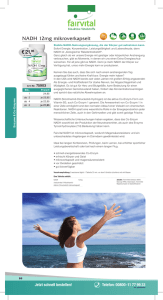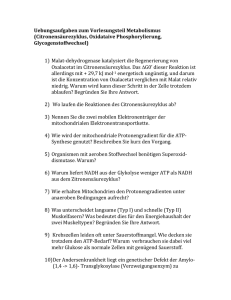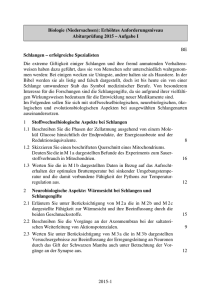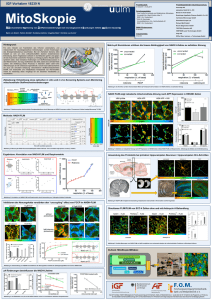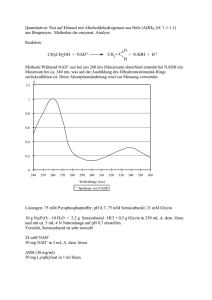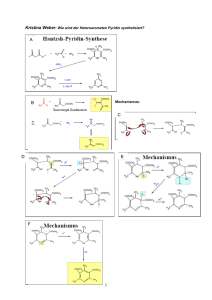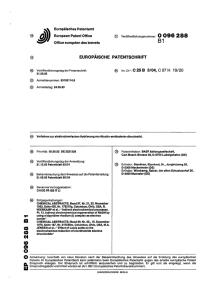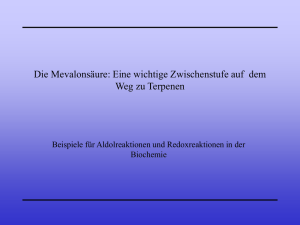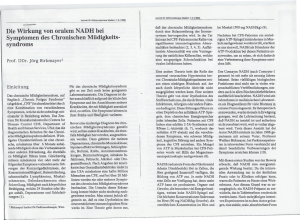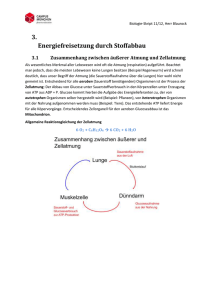Klebsiella pneumoniae and Vibrio alginolyticus - ETH E
Werbung
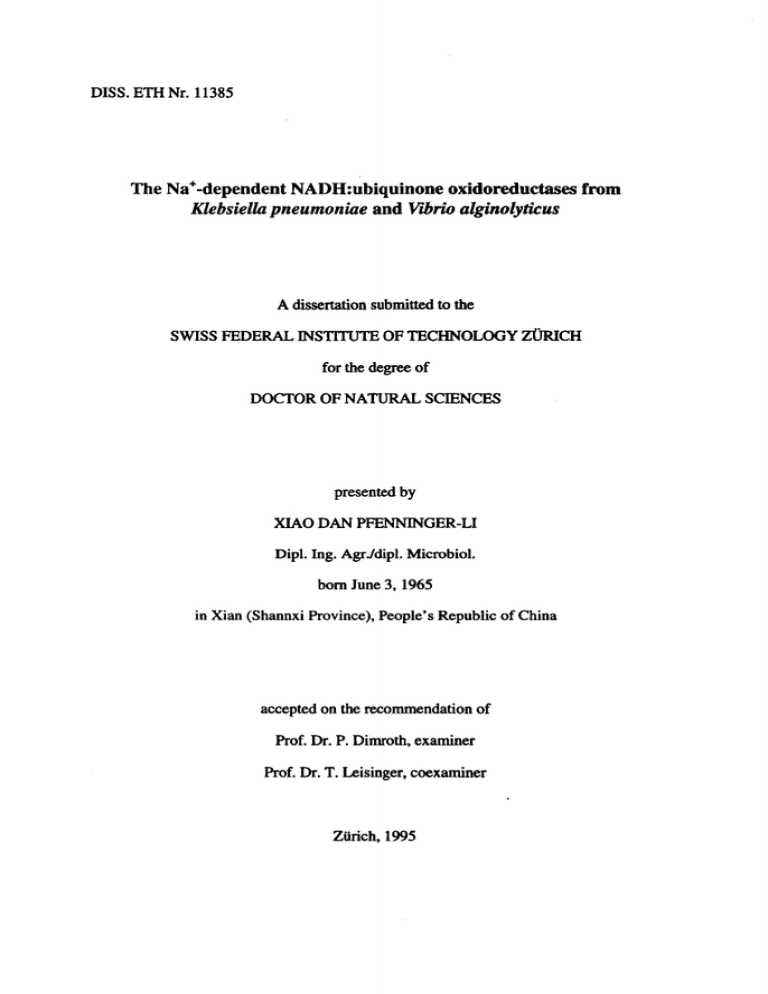
DISS.ETH Nr. 11385 The Na+-dependent NADH:ubiquinone oxidoreductases Klebsiella pneumoniae and Vibrio alginolyticus A dissertation submitted to the SWISS FEDERAL INSTITUTE OF TECHNOLOGY ZÜRICH for the degree of DOCTOR OF NATURAL SCIENCES presented by XIAO DAN PFENNINGER-LI Dipl. Ing. AgrVdipl. Microbiol. born June 3,1965 in Xian (Shannxi Province), People's Republic of China accepted on the recommendation of Prof. Dr. P. Dimroth, examiner Prof. Dr. T. Leisinger, coexaminer Zürich, 1995 from 5 Zusammenfassung/Summary 1. 1.1 Zusammenfassung Klebsiella als pneumoniae benötigt Natriumionen Kohlenstoff- einziger Symporter in die Zelle Oxalacetat wird und mit Hilfe der transportiert Acetat zu gebildet wird, welches für Formiat und 1.2 CO2. Die darauf weist Bildung hin, Reduktionsäquivalente dass von in Oxalacetat und die Durch weitere Reaktionen ATP durch Substratketten- NADH-Synthese Elektonenakzeptor Reaktionen verwendet werden kann. eine 1 Citrat entstehen aus Teiloxidation Elektronen solcher Zellen involviert. Die die Formiat von CO2 zu Citrat in den Zellkohlenstoff von membrangebundene Oxidation dient. In 2 Acetat, 0.5 als 1 Formiat und mehr als 1 CO2 pro weniger für die Assimilation Dehydrogenase katalysiert Ubichinon als ergibt: durch werden. Eine Verfugung gestellt offenbar in die ein biosynthetische Die Stöchiometrie der Citratfermentation Formiat Citrat-Lyase Na+-Citrat membrangebundene Na+-Pumpe, wobei umgesetzt, durch einen gewonnen wird. Ein Problem der Citratfermentation ist, dass kein phosphorylierung Citrat Citrat wird Decarboxylase, in Pyruvat und CO2 umgewandelt. Pyruvat NADH Energiequelle. Oxalacetat wird durch eine gespalten. Acetat und für das anaerobe Wachstum auf Citrat von Gegenwart zur Transportkette ist membrangebundene Formiat CO2, zu wobei eines elektrochemischen Na+- Gradienten, kann Chinol seine Elektronen auf NAD+ übertragen. Dabei wird NAD+ NADH reduziert (umgekehrter Elektonentransfer). einem chemischen Na+-Gradient Niveau NADH von K. wurde (ApNa+) pneumoniae in Gegenwart in Gegenwart Hydroxyquinoline-N-Oxid von (HQNO), NADH:Ubichinon Oxidoreduktase, die Reduktion man von von NAD+ zu waren und Ay von Die von einem aufgehoben. oder durch die Bildung. NADH-Bildung Bildung Zugabe von von für Inside-out Membranvesikel konnten katalysieren, wenn anlegte. Dieser setzt sich aus zusammen. Sowohl ApNa+ A\|f Sauerstoff oder durch NADH- Hemmstoff spezifischen bei 120 mV von gleicher Grössenordnung endogene Formiat zunahm. Die NADH mit Formiat als Elektrondonor essentiell für die NADH inaktivieren. gezeigt werden, dass mehr als -100 mV das Sauerstoff einen elektrochemischen Na+-Gradienten ApNa+ Es konnte zu den HQNO umgekehrten als auch konnten die Reaktion A|lNa+-gekoppelten 6 Elektronentransfer in anaeroben K. pneumoniae Zellen ist eine essentielle Synthese für die Vibrio von Zellmaterial alginolyticus sein Wachstum aus Citrat. ist ein fakultativ anaerob, marines Bakterium, das Na+ Ionen für benötigt. Dieser Organismus kann bei alkalischem Carbonylcyanid m-Chlorophenylhydrazon (CCCP), diesem NQR) Organismus als wurde eine Komponente bekannt war, bestand der Na+-abhägige Enzym aus nur aus Schwefel Cluster von Untereinheitenkomposition Gegenwart Protononophor, Wie bereits aus von wachsen. In (Na+- früheren Arbeiten gereinigten IT-abhängigen Da alle eukaryotischen prosthetische und die in drei Untereinheiten und enthielt sowohl mehreren Untereinheiten bestehen und als pH NADH:Ubichinon Oxidoreduktase prosthetische Gruppen. Oxidoreduktasen Organismen einem Atmungskette gefunden. dieses FAD als auch FMN als NADH:Ubichinon Anforderrung nur Gruppen und prokaryotischen FMN und mehrere Eisen- besitzen, wurden die Na+-NQR für die Na+-NQR prosthetischen Gruppen die genauer untersucht. In dieser Arbeit wurde ein alginolyticus dominante mit dem Banden, als Reinigungsverfahren von Detergenz Lauryldimethylamin N-Oxid (LDAO) etabliert. V. Vier sowie mehrere Nebenbanden konnten mittels SDS-PAGE einer gereinigten Preparation wurden neues sichtbar Genprodukte des identifiziert. Das gereinigte werden. Drei der vier dominanten gemacht nqr Operons, Enzym zeigt welches für sowohl NADH die Polypeptide Na+-NQR kodiert, Dehydrogenase Chinon Reduktase Aktivität. Die beiden Aktivitäten konnten wirksam durch als auch AgMonen (Kj 0.2 JIM) gehemmt werden. Die Chinon Reduktase Aktivität wurde durch HQNO (Ki 0.4 p.M) gehemmt und durch Nationen spektroskopische Analysen einen haben [2Fe-2S] Typ Eisen-Schwefel Funktionen der gereinigte Octylglucosid, in dass das Cluster als prosthetischen Gruppen Modell für den Elektronentransfer Die gezeigt, (K„, 10 mM) aktiviert. Chemische und gereinigte Enzym ein FAD und prosthetische Gruppen wurden untersucht und ein enthält. Die hypotethisches vorgeschlagen. NADH:Ubichinon Oxidoreduktase wurde durch Liposomen eingebaut und der Na+-Transport Verdünnung in die mit entsprechenden 7 Proteoliposomen Proteoliposomen untersucht. die Na+-Aufnähme in Stöchiometrie des Na+-Einstromes Ionen wurde geeigneten Unter durch lag HQNO oder Bedingungen katalysierten Gegenwart von diese NADH und Ubichinon-1. Die bei 0.5 Na+ pro NADH. Der Transport Monensin durch gehemmt, und von Na+- CCCP und Valinomycin stimuliert. Diese Daten beweisen, dass die Na*-NQR primäre Na+ Pumpe ist. Ein indirekter Na+-Transportmechanisrnus durch eine ein IT-abhängige NADH:Ubichinon aus Oxidoreduktase in Na7H+ Antiporter ist dadurch ausgeschlossen. V. alginolyticus isolierte Kombination mit einem 8 1.2 Summary Klebsiella pneumoniae needs sodium ions when grown under anaerobic condition with citrate as sole carbon and energy Citrate is source. Na+-citrate symporter and is then cleaved by citrate lyase Oxaloacetate is oxaloacetate forming degraded ATP by a and acetate. Na+-pump further reactions, pyruvate is converted to acetate phosphorylation. Substrate level by to oxaloacetate pyruvate and CO2 by the membrane-bound to decarboxylase. Through one into the cell transported problem A of the NADH is formed which could be used for citrate fermentation pathway is that no reactions. The of citrate fermentation is 1 citrate fermented to 2 acetate, stoichiometry 0.5 formale and 1.2 C02. The formation of less than 1 formate and citrate can be accounted for by provide reducing equivalent for the these cells. Membrane-bound formate C02 with ubiquinone gradient (Ap:Na+), the as assimilation of citrate apparently can into the oxidation of formate dehydrogenase catalyses was found that the an electrochemical Na+ endogenous pneumoniae increased in the presence of formate and in response of more than -100 mV. NADH formation the presence of oxygen inhibitor for application ApNa+ after addition of NADH:ubiquinone pneumoniae catalysed after or of was to a chemical completely same NADH formation and oxygen or Na+ abolished in hydroxyquinoline-N-oxide, a specific oxidoreductase. Inverted membrane vesicles of K. electrochemical Na+ and AH-* of about the to NADH level of K. the reduction of NAD* to NADH with formate an A synthesis by further deliver its electrons to NAD+ and reduce it NADH (reversed electron transfer). It gradient (ApNa+) carbon. cell involved in NADH electron acceptor. In the presence of quinol that 1 CO2 per the oxidation part of the formate to C02 in order to membrane-bound electron transport chain is to more biosynthetic gradient magnitude. Both electron donor of about 120 mV ApNa+ and t^V hydroxyquinoline-N-oxide A(iNa+-coupled as were consisting of essential for inactivated the reaction. The NADH formation by pneumoniae cells is essential requirement for the synthesis of cell material from the highly an oxidised citrate. reversed electron transfer in anaerobic K. 9 Vibrio ions for is alginolyticus a falcutative anaerobic marine bacterium that growth. Remarkably, the proton this organism grow at alkaline can chain component. According containing are both FMN and FAD sulfur Clusters composed as prosthetic as oxidoreductases of much respiratory as a groups. Since all from purified H*- and eukaryotic three prokaryotic subunits and contain FMN and several iron- more groups, the subunit prosthetic found was A Na*- previous work, the enzyme is composed of to translocating NADH:ubiquinone organisms pH ionophore carbonyl Cyanide m-chlorophenylhydrazone (CCCP). dependent NADH:ubiquinone oxidoreductase (Na*-NQR) subunits requires Na* in the presence of compositum and the prosthetic groups present in this enzyme have been re-examined. In this the work, a preparation. products inhibited number of minor bands dehydrogenase quinone by Ag+ ions (K, inhibited by HQNO (K, JIM) 0.4 spectroscopic analyses [2Fe-2S] type a and and visible groups have been studied and as an the of V. alginolyticus purified have been identified The purified gene as enzyme showed reductase activities. The two activities The |iM). activated quinone by Na* with established. Four dominant SDS-PAGE of the on Na+-NQR. have revealed that the iron-sulfur Cluster was Polypeptides 0.2 was Na*-NQR (LDAO) were the nqr Operon which encodes both NADH effectively N-oxide Three of the four dominant of for the purification procedura detergent lauryldimethylamine bands and and a new ions reductase were activity was (K„ 10 mM). Chemical purified enzyme contained prosthetic groups. Functions a of the FAD and prosthetic model of electron transfer has been hypothetical proposed. Purified detergent dilution proteoliposomes with was catalysed Na* uptake stoichiometry or octyl glucoside investigated. Under was incorporated Na+ and Na*-NQR CCCP isolated from V. or valinomycin. alginolyticus is a liposomes by into the ubiquinone-1 of 0.5 Na+ per NADH. The transport of Na* ions by into transport proper conditions, in the presence of NADH and monensin and stimulated that the oxidoreductase NADH:ubiquinone the derived proteoliposomes with an apparent was inhibited by HQNO These data provided firm primary Na* pump. proof An indirect Na* 10 transport mechanism by combination with a a H^translocating NADH:ubiquinone oxidoreductase Na+/H* antiporter has therefore been excluded. in

